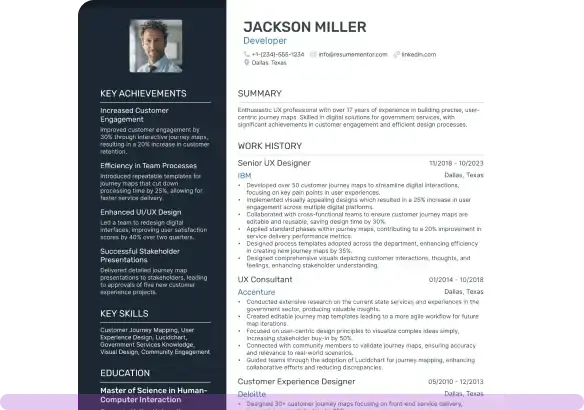Business Intelligence Analyst Resume Examples

Mar 26, 2025
|
12 min read
Unlock your data-driven future with this resume guide designed to spotlight your business intelligence analyst skills. Learn how to decode job descriptions and paint a clear picture of your analytical expertise.
Rated by 348 people
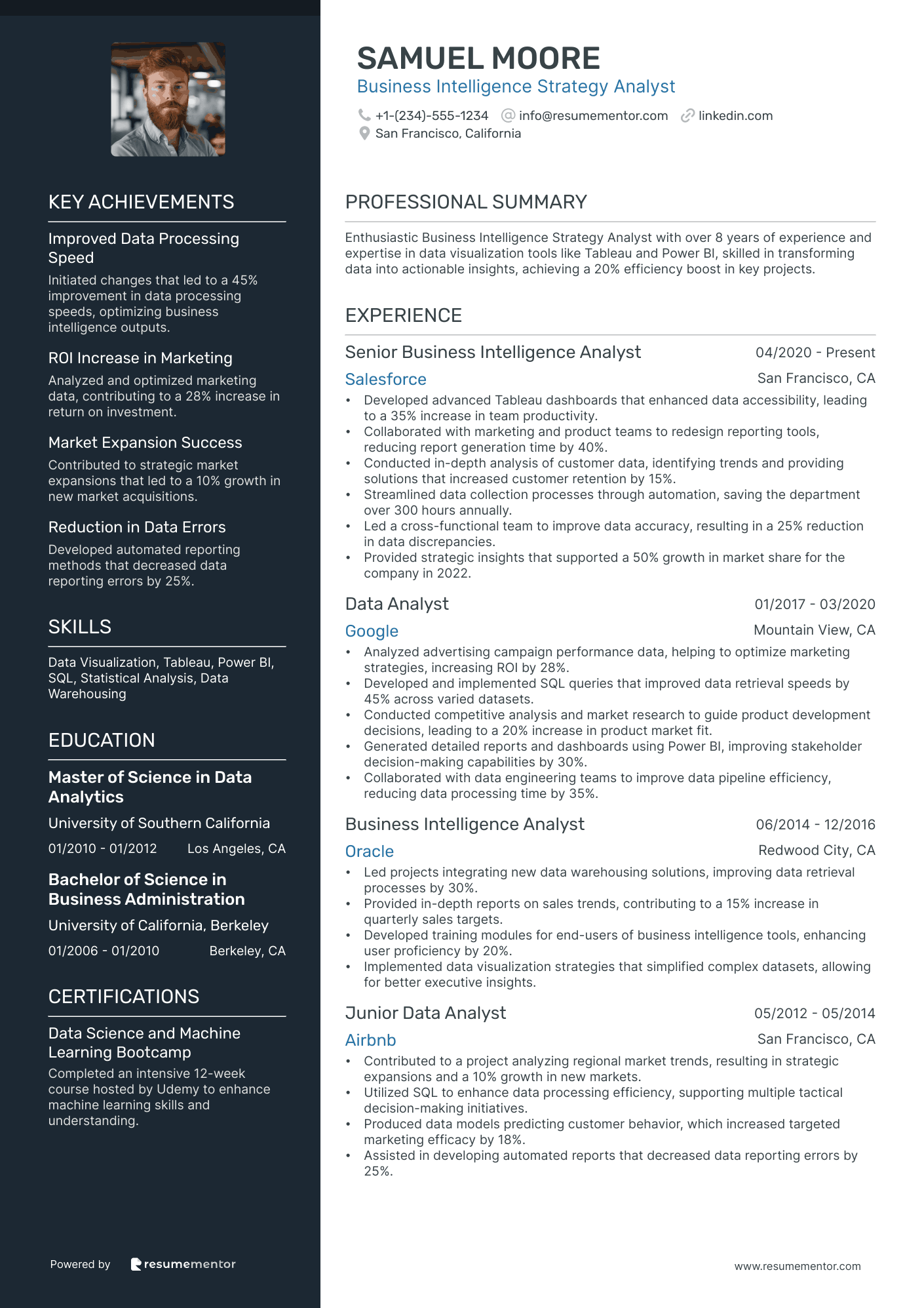
Business Intelligence Strategy Analyst
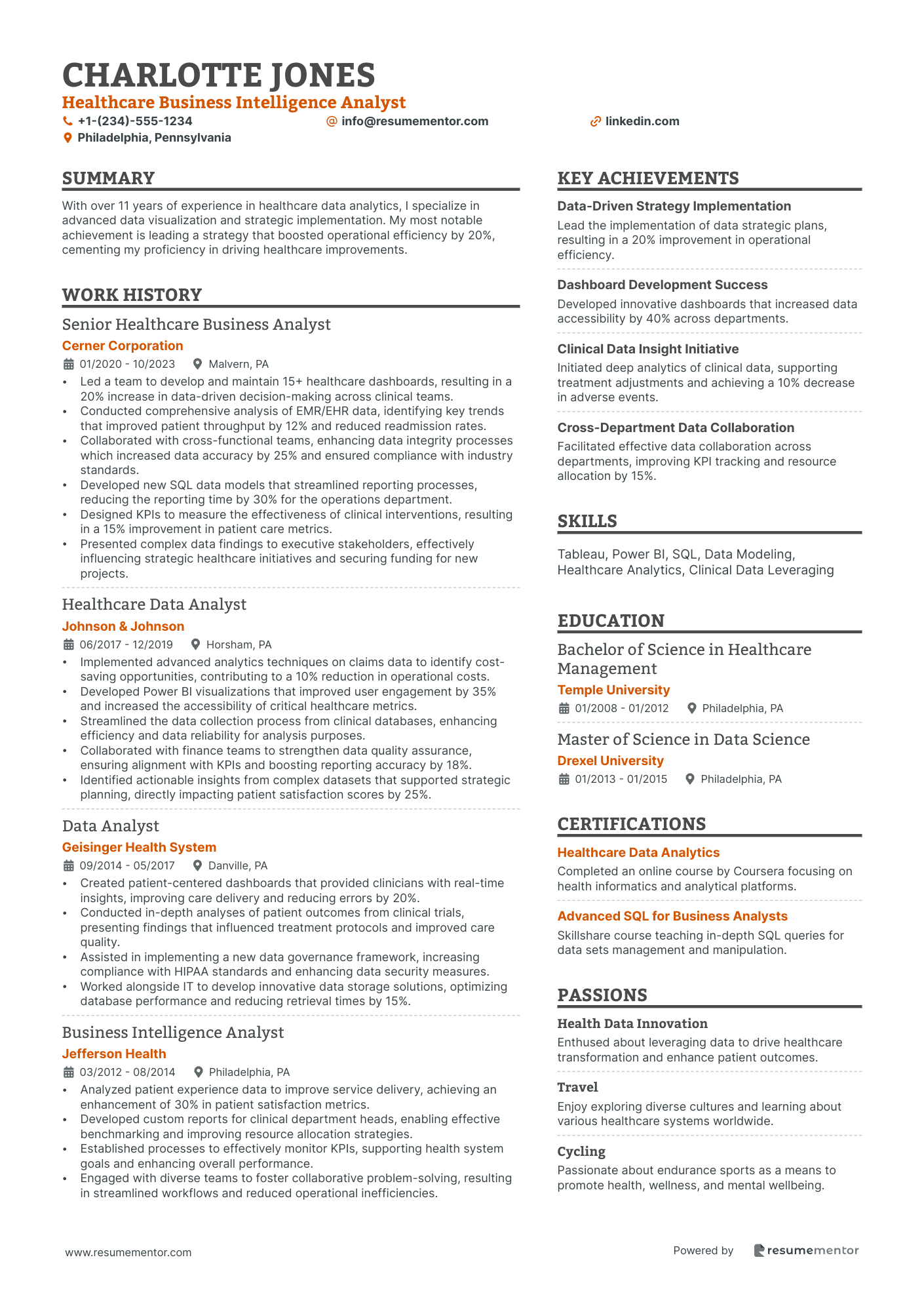
Healthcare Business Intelligence Analyst
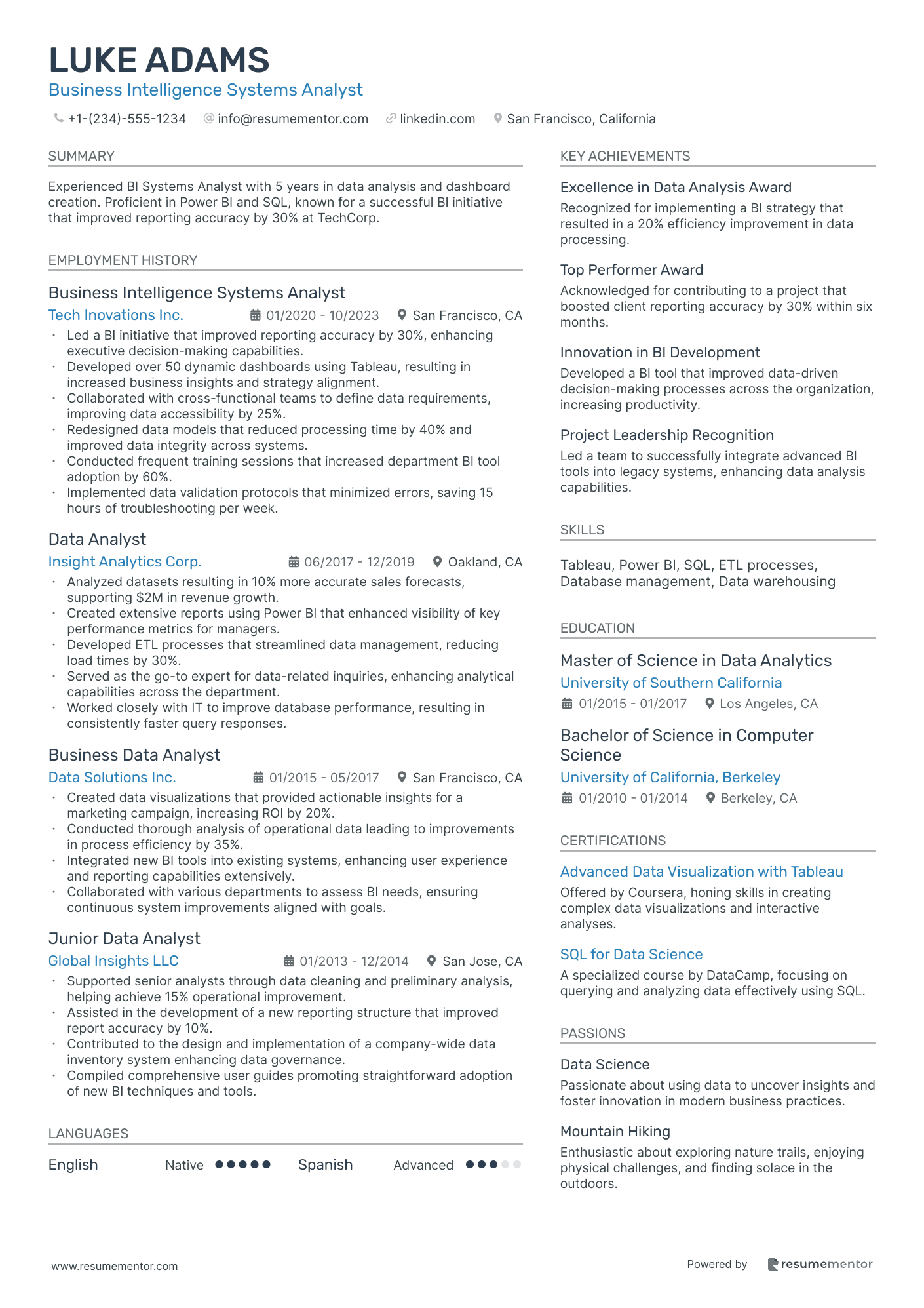
Business Intelligence Systems Analyst

Financial Business Intelligence Analyst
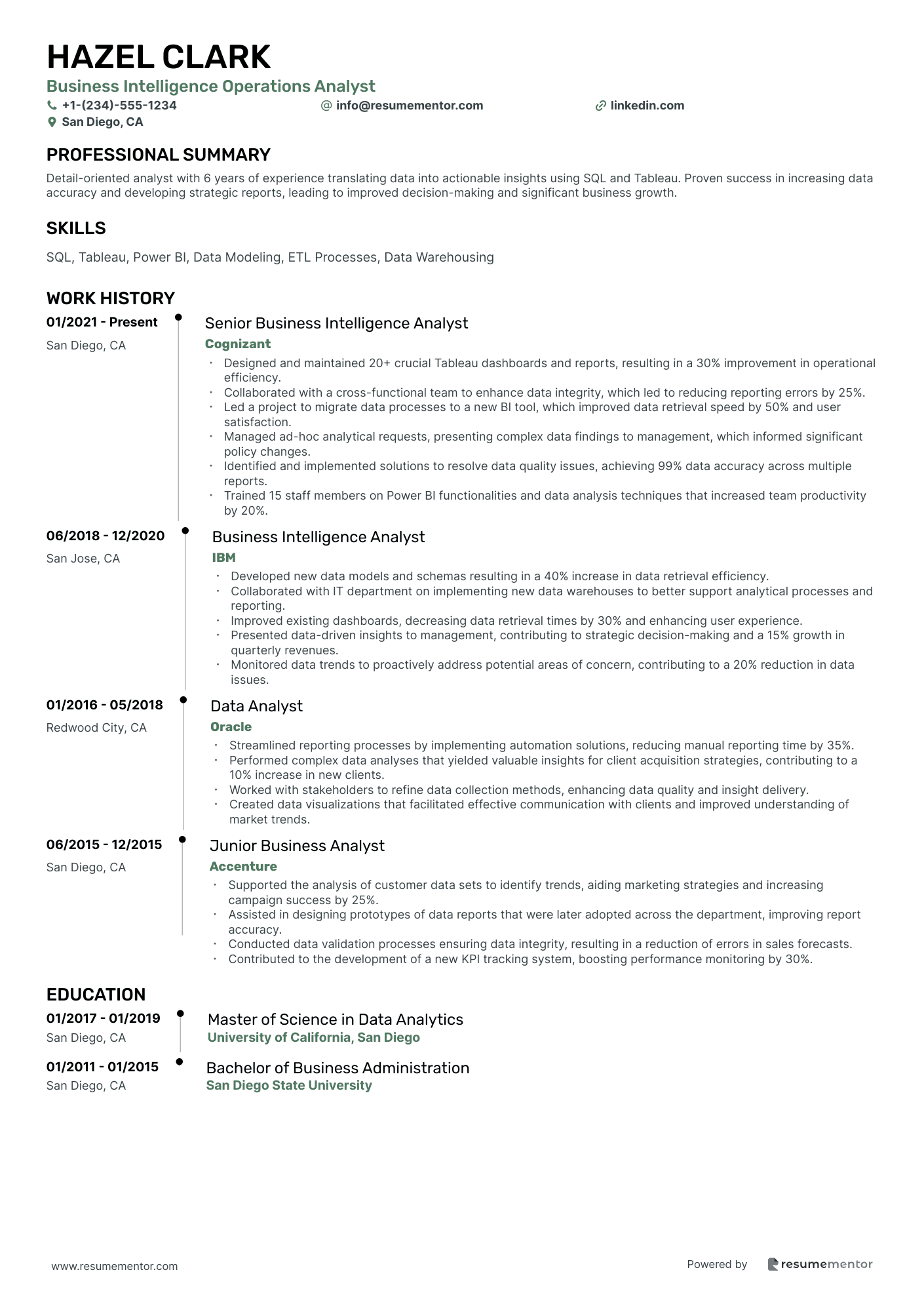
Business Intelligence Operations Analyst
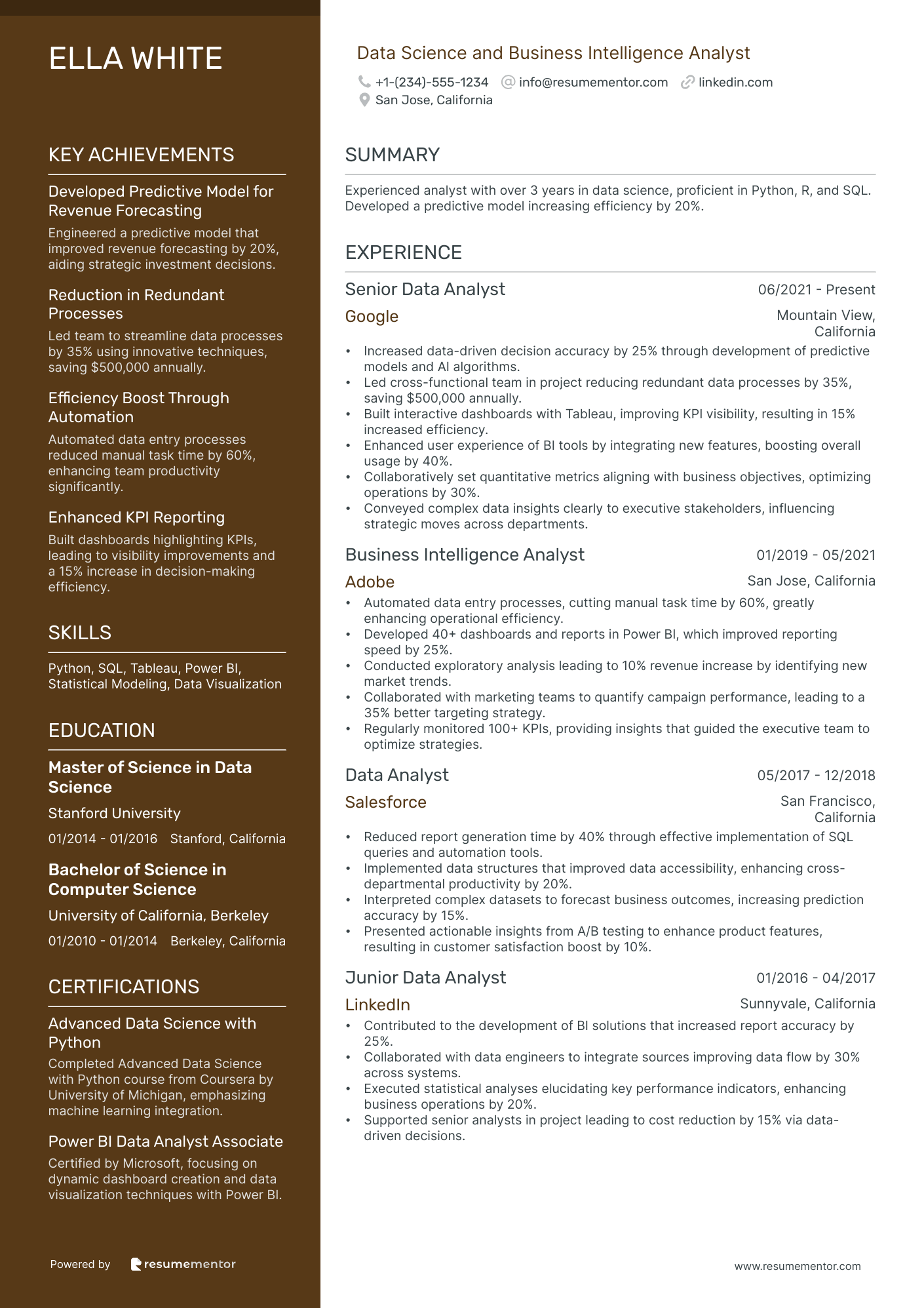
Data Science and Business Intelligence Analyst

Retail Business Intelligence Analyst
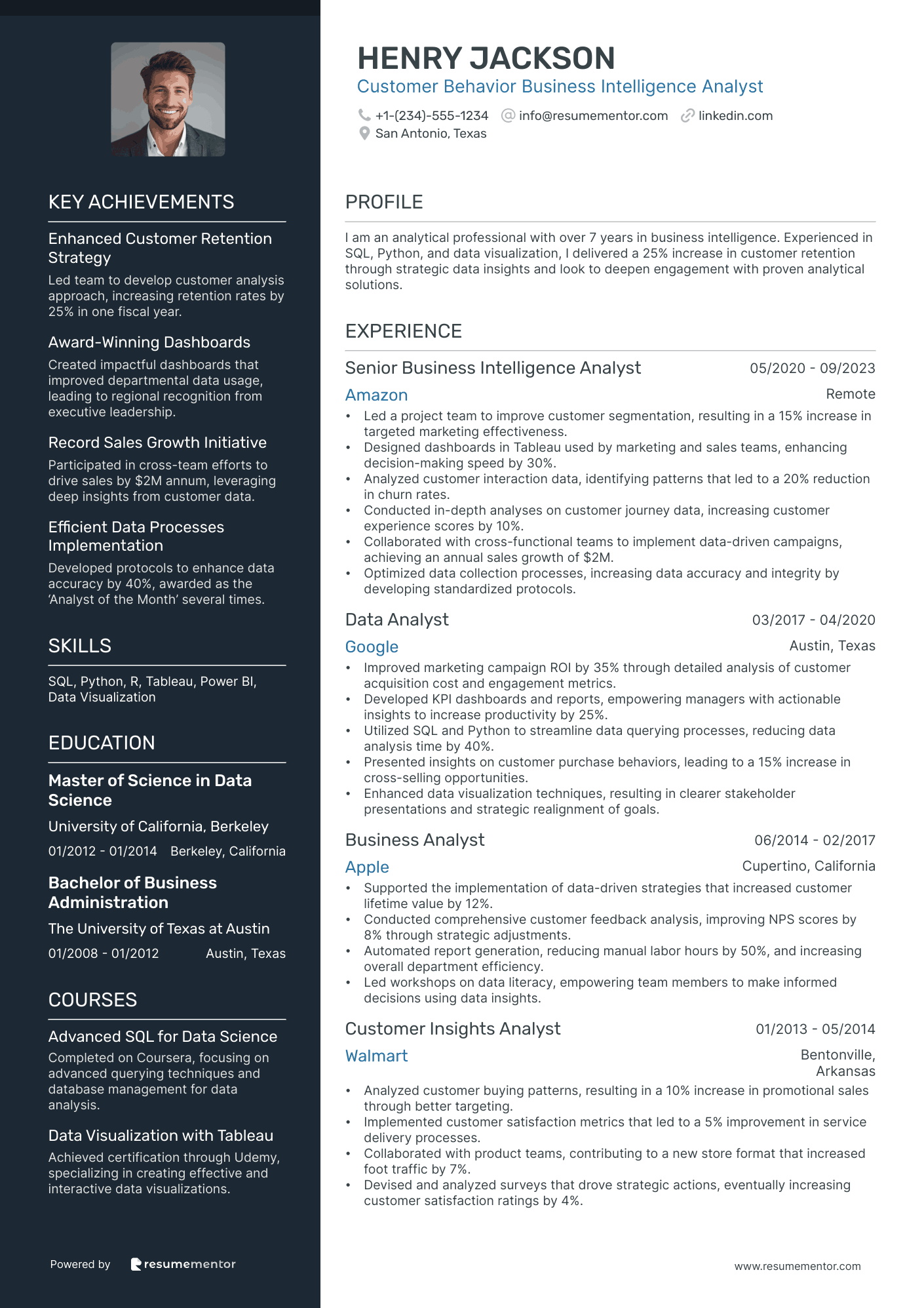
Customer Behavior Business Intelligence Analyst
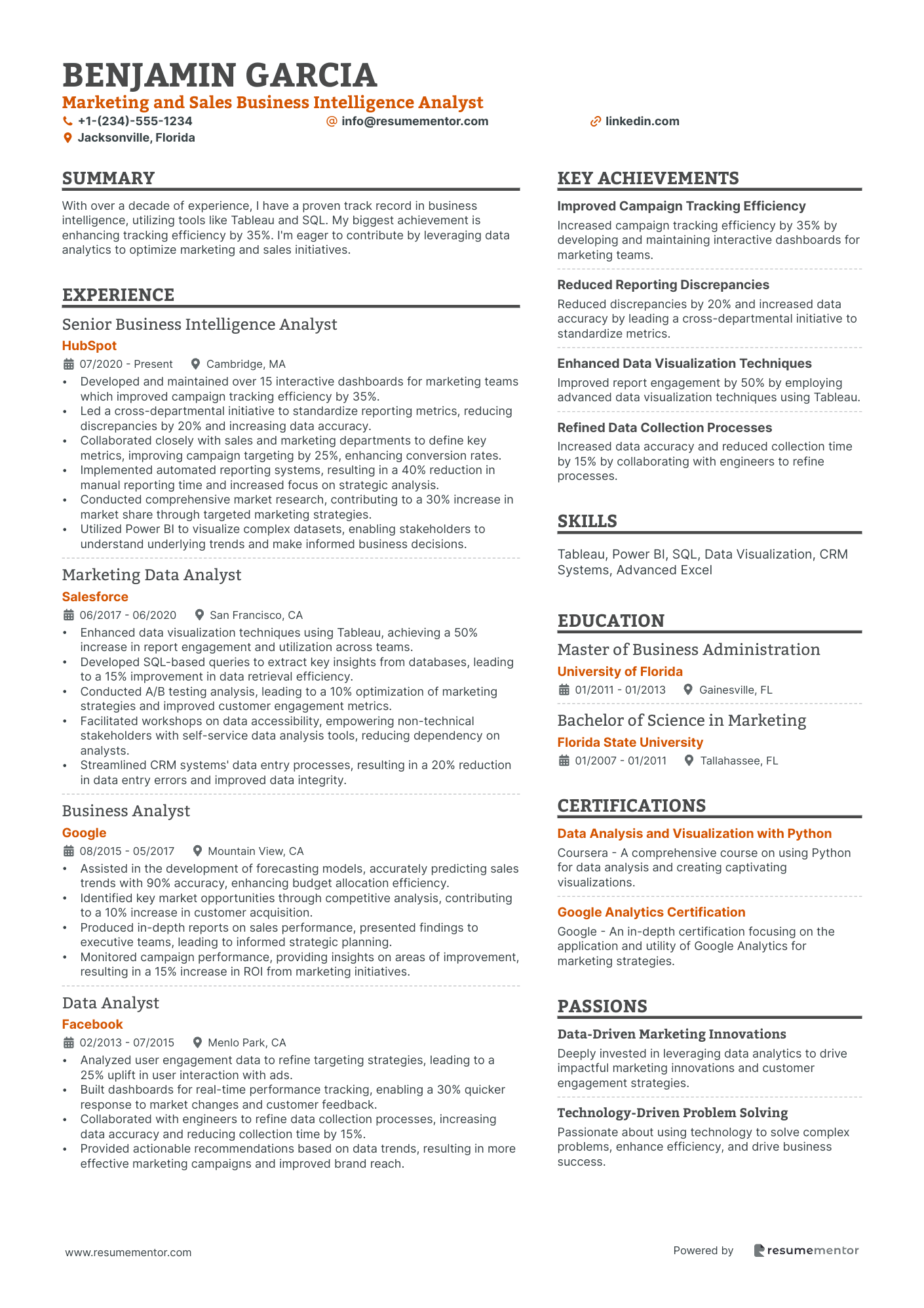
Marketing and Sales Business Intelligence Analyst
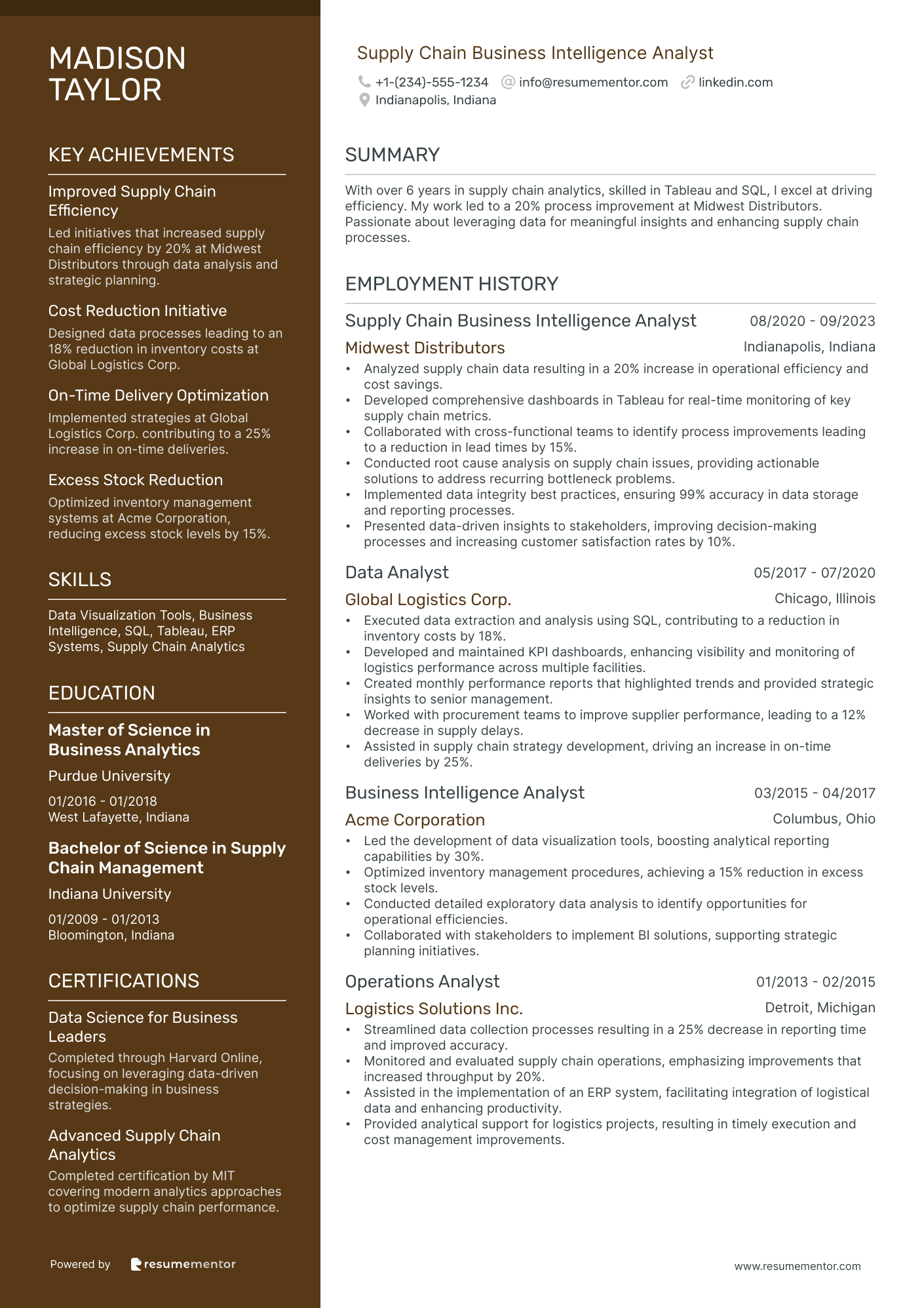
Supply Chain Business Intelligence Analyst

Business Intelligence Strategy Analyst resume sample
- •Developed advanced Tableau dashboards that enhanced data accessibility, leading to a 35% increase in team productivity.
- •Collaborated with marketing and product teams to redesign reporting tools, reducing report generation time by 40%.
- •Conducted in-depth analysis of customer data, identifying trends and providing solutions that increased customer retention by 15%.
- •Streamlined data collection processes through automation, saving the department over 300 hours annually.
- •Led a cross-functional team to improve data accuracy, resulting in a 25% reduction in data discrepancies.
- •Provided strategic insights that supported a 50% growth in market share for the company in 2022.
- •Analyzed advertising campaign performance data, helping to optimize marketing strategies, increasing ROI by 28%.
- •Developed and implemented SQL queries that improved data retrieval speeds by 45% across varied datasets.
- •Conducted competitive analysis and market research to guide product development decisions, leading to a 20% increase in product market fit.
- •Generated detailed reports and dashboards using Power BI, improving stakeholder decision-making capabilities by 30%.
- •Collaborated with data engineering teams to improve data pipeline efficiency, reducing data processing time by 35%.
- •Led projects integrating new data warehousing solutions, improving data retrieval processes by 30%.
- •Provided in-depth reports on sales trends, contributing to a 15% increase in quarterly sales targets.
- •Developed training modules for end-users of business intelligence tools, enhancing user proficiency by 20%.
- •Implemented data visualization strategies that simplified complex datasets, allowing for better executive insights.
- •Contributed to a project analyzing regional market trends, resulting in strategic expansions and a 10% growth in new markets.
- •Utilized SQL to enhance data processing efficiency, supporting multiple tactical decision-making initiatives.
- •Produced data models predicting customer behavior, which increased targeted marketing efficacy by 18%.
- •Assisted in developing automated reports that decreased data reporting errors by 25%.
Healthcare Business Intelligence Analyst resume sample
- •Led a team to develop and maintain 15+ healthcare dashboards, resulting in a 20% increase in data-driven decision-making across clinical teams.
- •Conducted comprehensive analysis of EMR/EHR data, identifying key trends that improved patient throughput by 12% and reduced readmission rates.
- •Collaborated with cross-functional teams, enhancing data integrity processes which increased data accuracy by 25% and ensured compliance with industry standards.
- •Developed new SQL data models that streamlined reporting processes, reducing the reporting time by 30% for the operations department.
- •Designed KPIs to measure the effectiveness of clinical interventions, resulting in a 15% improvement in patient care metrics.
- •Presented complex data findings to executive stakeholders, effectively influencing strategic healthcare initiatives and securing funding for new projects.
- •Implemented advanced analytics techniques on claims data to identify cost-saving opportunities, contributing to a 10% reduction in operational costs.
- •Developed Power BI visualizations that improved user engagement by 35% and increased the accessibility of critical healthcare metrics.
- •Streamlined the data collection process from clinical databases, enhancing efficiency and data reliability for analysis purposes.
- •Collaborated with finance teams to strengthen data quality assurance, ensuring alignment with KPIs and boosting reporting accuracy by 18%.
- •Identified actionable insights from complex datasets that supported strategic planning, directly impacting patient satisfaction scores by 25%.
- •Created patient-centered dashboards that provided clinicians with real-time insights, improving care delivery and reducing errors by 20%.
- •Conducted in-depth analyses of patient outcomes from clinical trials, presenting findings that influenced treatment protocols and improved care quality.
- •Assisted in implementing a new data governance framework, increasing compliance with HIPAA standards and enhancing data security measures.
- •Worked alongside IT to develop innovative data storage solutions, optimizing database performance and reducing retrieval times by 15%.
- •Analyzed patient experience data to improve service delivery, achieving an enhancement of 30% in patient satisfaction metrics.
- •Developed custom reports for clinical department heads, enabling effective benchmarking and improving resource allocation strategies.
- •Established processes to effectively monitor KPIs, supporting health system goals and enhancing overall performance.
- •Engaged with diverse teams to foster collaborative problem-solving, resulting in streamlined workflows and reduced operational inefficiencies.
Business Intelligence Systems Analyst resume sample
- •Led a BI initiative that improved reporting accuracy by 30%, enhancing executive decision-making capabilities.
- •Developed over 50 dynamic dashboards using Tableau, resulting in increased business insights and strategy alignment.
- •Collaborated with cross-functional teams to define data requirements, improving data accessibility by 25%.
- •Redesigned data models that reduced processing time by 40% and improved data integrity across systems.
- •Conducted frequent training sessions that increased department BI tool adoption by 60%.
- •Implemented data validation protocols that minimized errors, saving 15 hours of troubleshooting per week.
- •Analyzed datasets resulting in 10% more accurate sales forecasts, supporting $2M in revenue growth.
- •Created extensive reports using Power BI that enhanced visibility of key performance metrics for managers.
- •Developed ETL processes that streamlined data management, reducing load times by 30%.
- •Served as the go-to expert for data-related inquiries, enhancing analytical capabilities across the department.
- •Worked closely with IT to improve database performance, resulting in consistently faster query responses.
- •Created data visualizations that provided actionable insights for a marketing campaign, increasing ROI by 20%.
- •Conducted thorough analysis of operational data leading to improvements in process efficiency by 35%.
- •Integrated new BI tools into existing systems, enhancing user experience and reporting capabilities extensively.
- •Collaborated with various departments to assess BI needs, ensuring continuous system improvements aligned with goals.
- •Supported senior analysts through data cleaning and preliminary analysis, helping achieve 15% operational improvement.
- •Assisted in the development of a new reporting structure that improved report accuracy by 10%.
- •Contributed to the design and implementation of a company-wide data inventory system enhancing data governance.
- •Compiled comprehensive user guides promoting straightforward adoption of new BI techniques and tools.
Financial Business Intelligence Analyst resume sample
- •Developed 10+ financial models to forecast revenue and optimize costs, increasing forecast accuracy by 20%.
- •Streamlined the reporting process using Power BI, reducing the preparation time by 30% for financial dashboards.
- •Collaborated with 5 cross-functional teams to align financial reports with business needs, resulting in a shared understanding of financial performance.
- •Conducted extensive ad-hoc analyses for upper management, improving strategic decision-making processes by 25%.
- •Improved data integrity by designing a new auditing process, resulting in a 10% decrease in data discrepancies.
- •Conducted monthly reviews of KPIs, leading to the early identification of potential market shifts, enhancing business agility.
- •Analyzed customer data to derive insights, contributing to a 15% increase in client retention through targeted financial strategies.
- •Led the upgrade of financial visualization tools, boosting the efficiency of data manipulation processes by 25%.
- •Facilitated the integration of new ERP systems within the finance department to improve organizational workflow by 30%.
- •Conducted quantitative analysis and presented findings in polished reports to stakeholders, enhancing financial transparency and communication.
- •Managed and validated large datasets to ensure data accuracy, maintaining a comprehensive database with 99% accuracy in financial metrics.
- •Developed financial dashboards using Tableau to monitor and visualize daily business KPIs, improving operational insights by 18%.
- •Conducted financial trend analysis that led to strategic changes, resulting in a 12% improvement in profit margins.
- •Participated in cross-departmental data projects to ensure continuous improvement in data reporting standards.
- •Implemented data validation protocols reducing error rates in financial reports by 15%.
- •Managed end-to-end financial analysis for quarterly reports, driving strategic decision-making with precise and actionable data.
- •Optimized financial modeling techniques which resulted in a 10% enhancement in forecast accuracy.
- •Collaborated with the IT and finance teams to implement a new business intelligence system that increased reporting capabilities.
- •Led a team of junior analysts to ensure all financial data was accurate, reducing report inaccuracies by 14%.
Business Intelligence Operations Analyst resume sample
- •Designed and maintained 20+ crucial Tableau dashboards and reports, resulting in a 30% improvement in operational efficiency.
- •Collaborated with a cross-functional team to enhance data integrity, which led to reducing reporting errors by 25%.
- •Led a project to migrate data processes to a new BI tool, which improved data retrieval speed by 50% and user satisfaction.
- •Managed ad-hoc analytical requests, presenting complex data findings to management, which informed significant policy changes.
- •Identified and implemented solutions to resolve data quality issues, achieving 99% data accuracy across multiple reports.
- •Trained 15 staff members on Power BI functionalities and data analysis techniques that increased team productivity by 20%.
- •Developed new data models and schemas resulting in a 40% increase in data retrieval efficiency.
- •Collaborated with IT department on implementing new data warehouses to better support analytical processes and reporting.
- •Improved existing dashboards, decreasing data retrieval times by 30% and enhancing user experience.
- •Presented data-driven insights to management, contributing to strategic decision-making and a 15% growth in quarterly revenues.
- •Monitored data trends to proactively address potential areas of concern, contributing to a 20% reduction in data issues.
- •Streamlined reporting processes by implementing automation solutions, reducing manual reporting time by 35%.
- •Performed complex data analyses that yielded valuable insights for client acquisition strategies, contributing to a 10% increase in new clients.
- •Worked with stakeholders to refine data collection methods, enhancing data quality and insight delivery.
- •Created data visualizations that facilitated effective communication with clients and improved understanding of market trends.
- •Supported the analysis of customer data sets to identify trends, aiding marketing strategies and increasing campaign success by 25%.
- •Assisted in designing prototypes of data reports that were later adopted across the department, improving report accuracy.
- •Conducted data validation processes ensuring data integrity, resulting in a reduction of errors in sales forecasts.
- •Contributed to the development of a new KPI tracking system, boosting performance monitoring by 30%.
Data Science and Business Intelligence Analyst resume sample
- •Increased data-driven decision accuracy by 25% through development of predictive models and AI algorithms.
- •Led cross-functional team in project reducing redundant data processes by 35%, saving $500,000 annually.
- •Built interactive dashboards with Tableau, improving KPI visibility, resulting in 15% increased efficiency.
- •Enhanced user experience of BI tools by integrating new features, boosting overall usage by 40%.
- •Collaboratively set quantitative metrics aligning with business objectives, optimizing operations by 30%.
- •Conveyed complex data insights clearly to executive stakeholders, influencing strategic moves across departments.
- •Automated data entry processes, cutting manual task time by 60%, greatly enhancing operational efficiency.
- •Developed 40+ dashboards and reports in Power BI, which improved reporting speed by 25%.
- •Conducted exploratory analysis leading to 10% revenue increase by identifying new market trends.
- •Collaborated with marketing teams to quantify campaign performance, leading to a 35% better targeting strategy.
- •Regularly monitored 100+ KPIs, providing insights that guided the executive team to optimize strategies.
- •Reduced report generation time by 40% through effective implementation of SQL queries and automation tools.
- •Implemented data structures that improved data accessibility, enhancing cross-departmental productivity by 20%.
- •Interpreted complex datasets to forecast business outcomes, increasing prediction accuracy by 15%.
- •Presented actionable insights from A/B testing to enhance product features, resulting in customer satisfaction boost by 10%.
- •Contributed to the development of BI solutions that increased report accuracy by 25%.
- •Collaborated with data engineers to integrate sources improving data flow by 30% across systems.
- •Executed statistical analyses elucidating key performance indicators, enhancing business operations by 20%.
- •Supported senior analysts in project leading to cost reduction by 15% via data-driven decisions.
Retail Business Intelligence Analyst resume sample
- •Led the development of interactive retail dashboards using Tableau, resulting in increased efficiency for sales strategy evaluations.
- •Collaborated with cross-functional teams to analyze customer trends, generating insights that improved customer retention by 15%.
- •Implemented predictive analytics models for inventory planning, decreasing overstock by 20% and minimizing inventory costs.
- •Designed KPIs for sales performance analysis, allowing stakeholders to identify underperforming areas and improve strategies.
- •Orchestrated the data collection processes, streamlining reporting with business intelligence tools and reducing manual labor by 30%.
- •Presented complex analytical insights to senior management, translating technical data into actionable growth strategies.
- •Analyzed sales data across various departments, leading to the identification of major sales opportunities effectively growing revenue by 12%.
- •Collaborated with marketing and operations, providing data-driven insights that enhanced weekly promotional campaigns, boosting customer engagement.
- •Developed custom SQL queries to extract critical business data for stakeholders resulting in a 25% faster reporting speed.
- •Assisted with the development of KPIs, enabling more strategic decision-making for inventory management.
- •Managed comprehensive competitive analysis, guiding the strategic direction and leading to an 8% increase in market share.
- •Contributed to a team implementing a new business intelligence system, increasing data accuracy and accessibility by 40%.
- •Generated detailed reports on merchandising performance, providing actionable insights for improving department-level strategies.
- •Monitored and analyzed retail sales data for trends, informing merchandising decisions and significantly reducing markdown losses.
- •Supported marketing initiatives with data-driven forecasts, effectively aligning product offerings with consumer demand patterns.
- •Developed and managed Excel-based dashboards for tracking daily sales performance, aiding in more informed decision-making.
- •Identified and communicated key competitive insights, leading to strategic adjustments that improved online sales by 10%.
- •Assisted in inventory management processes by providing trend analysis, improving stock replenishment efficiency.
- •Conducted comprehensive market research to support strategic initiatives, resulting in enhanced alignment of product offerings.
Customer Behavior Business Intelligence Analyst resume sample
- •Led a project team to improve customer segmentation, resulting in a 15% increase in targeted marketing effectiveness.
- •Designed dashboards in Tableau used by marketing and sales teams, enhancing decision-making speed by 30%.
- •Analyzed customer interaction data, identifying patterns that led to a 20% reduction in churn rates.
- •Conducted in-depth analyses on customer journey data, increasing customer experience scores by 10%.
- •Collaborated with cross-functional teams to implement data-driven campaigns, achieving an annual sales growth of $2M.
- •Optimized data collection processes, increasing data accuracy and integrity by developing standardized protocols.
- •Improved marketing campaign ROI by 35% through detailed analysis of customer acquisition cost and engagement metrics.
- •Developed KPI dashboards and reports, empowering managers with actionable insights to increase productivity by 25%.
- •Utilized SQL and Python to streamline data querying processes, reducing data analysis time by 40%.
- •Presented insights on customer purchase behaviors, leading to a 15% increase in cross-selling opportunities.
- •Enhanced data visualization techniques, resulting in clearer stakeholder presentations and strategic realignment of goals.
- •Supported the implementation of data-driven strategies that increased customer lifetime value by 12%.
- •Conducted comprehensive customer feedback analysis, improving NPS scores by 8% through strategic adjustments.
- •Automated report generation, reducing manual labor hours by 50%, and increasing overall department efficiency.
- •Led workshops on data literacy, empowering team members to make informed decisions using data insights.
- •Analyzed customer buying patterns, resulting in a 10% increase in promotional sales through better targeting.
- •Implemented customer satisfaction metrics that led to a 5% improvement in service delivery processes.
- •Collaborated with product teams, contributing to a new store format that increased foot traffic by 7%.
- •Devised and analyzed surveys that drove strategic actions, eventually increasing customer satisfaction ratings by 4%.
Marketing and Sales Business Intelligence Analyst resume sample
- •Developed and maintained over 15 interactive dashboards for marketing teams which improved campaign tracking efficiency by 35%.
- •Led a cross-departmental initiative to standardize reporting metrics, reducing discrepancies by 20% and increasing data accuracy.
- •Collaborated closely with sales and marketing departments to define key metrics, improving campaign targeting by 25%, enhancing conversion rates.
- •Implemented automated reporting systems, resulting in a 40% reduction in manual reporting time and increased focus on strategic analysis.
- •Conducted comprehensive market research, contributing to a 30% increase in market share through targeted marketing strategies.
- •Utilized Power BI to visualize complex datasets, enabling stakeholders to understand underlying trends and make informed business decisions.
- •Enhanced data visualization techniques using Tableau, achieving a 50% increase in report engagement and utilization across teams.
- •Developed SQL-based queries to extract key insights from databases, leading to a 15% improvement in data retrieval efficiency.
- •Conducted A/B testing analysis, leading to a 10% optimization of marketing strategies and improved customer engagement metrics.
- •Facilitated workshops on data accessibility, empowering non-technical stakeholders with self-service data analysis tools, reducing dependency on analysts.
- •Streamlined CRM systems' data entry processes, resulting in a 20% reduction in data entry errors and improved data integrity.
- •Assisted in the development of forecasting models, accurately predicting sales trends with 90% accuracy, enhancing budget allocation efficiency.
- •Identified key market opportunities through competitive analysis, contributing to a 10% increase in customer acquisition.
- •Produced in-depth reports on sales performance, presented findings to executive teams, leading to informed strategic planning.
- •Monitored campaign performance, providing insights on areas of improvement, resulting in a 15% increase in ROI from marketing initiatives.
- •Analyzed user engagement data to refine targeting strategies, leading to a 25% uplift in user interaction with ads.
- •Built dashboards for real-time performance tracking, enabling a 30% quicker response to market changes and customer feedback.
- •Collaborated with engineers to refine data collection processes, increasing data accuracy and reducing collection time by 15%.
- •Provided actionable recommendations based on data trends, resulting in more effective marketing campaigns and improved brand reach.
Supply Chain Business Intelligence Analyst resume sample
- •Analyzed supply chain data resulting in a 20% increase in operational efficiency and cost savings.
- •Developed comprehensive dashboards in Tableau for real-time monitoring of key supply chain metrics.
- •Collaborated with cross-functional teams to identify process improvements leading to a reduction in lead times by 15%.
- •Conducted root cause analysis on supply chain issues, providing actionable solutions to address recurring bottleneck problems.
- •Implemented data integrity best practices, ensuring 99% accuracy in data storage and reporting processes.
- •Presented data-driven insights to stakeholders, improving decision-making processes and increasing customer satisfaction rates by 10%.
- •Executed data extraction and analysis using SQL, contributing to a reduction in inventory costs by 18%.
- •Developed and maintained KPI dashboards, enhancing visibility and monitoring of logistics performance across multiple facilities.
- •Created monthly performance reports that highlighted trends and provided strategic insights to senior management.
- •Worked with procurement teams to improve supplier performance, leading to a 12% decrease in supply delays.
- •Assisted in supply chain strategy development, driving an increase in on-time deliveries by 25%.
- •Led the development of data visualization tools, boosting analytical reporting capabilities by 30%.
- •Optimized inventory management procedures, achieving a 15% reduction in excess stock levels.
- •Conducted detailed exploratory data analysis to identify opportunities for operational efficiencies.
- •Collaborated with stakeholders to implement BI solutions, supporting strategic planning initiatives.
- •Streamlined data collection processes resulting in a 25% decrease in reporting time and improved accuracy.
- •Monitored and evaluated supply chain operations, emphasizing improvements that increased throughput by 20%.
- •Assisted in the implementation of an ERP system, facilitating integration of logistical data and enhancing productivity.
- •Provided analytical support for logistics projects, resulting in timely execution and cost management improvements.
Crafting a business intelligence analyst resume can feel like piecing together a complex puzzle—it’s about fitting each element perfectly to showcase your skills and accomplishments. As someone skilled in transforming data into powerful insights, you face the unique challenge of translating this into a compelling resume.
In a competitive job market, precision is everything, and your resume is often your first impression, acting as evidence of your analytical prowess. The key is to highlight your accomplishments clearly while ensuring that your skills shine through effectively.
A well-structured layout can guide you in making your achievements the focal point without getting lost in details. Here, using a resume template becomes invaluable, providing a framework that helps organize your story in a concise way. This structure allows you to turn your skills into a narrative that captures the attention of hiring managers effortlessly. To find a starting point that matches your needs, explore resume templates.
Communicating your value shouldn't feel daunting. Equipped with the right tools and insights, you can craft a resume that truly reflects your professional journey. This guide is designed to help you navigate the process, turning resume writing into a rewarding opportunity to stand out in your field.
Key Takeaways
- A business intelligence analyst resume should highlight your ability to transform data into actionable insights and should be tailored to the specific job description and desired skills.
- A structured layout with clear sections such as Professional Summary, Work Experience, Education, Skills, and Certifications helps organize your accomplishments and presents them effectively to hiring managers.
- The reverse chronological format typically suits business intelligence roles, emphasizing recent and relevant experience while maintaining clean, professional formatting standards such as font choice and PDF format.
- Quantifiable achievements and the use of action verbs are essential in the Experience section to demonstrate your impact through data analysis and problem-solving skills in previous roles.
- Highlight both technical skills, like SQL and data visualization tools, and soft skills, like critical thinking and teamwork, to align with industry demands and showcase comprehensive expertise.
What to focus on when writing your business intelligence analyst resume
A business intelligence analyst resume should effectively communicate your skills in turning data into actionable insights. It needs to immediately capture a recruiter's attention by emphasizing not just your analytical abilities but also how these skills translate into strategic advantages for a company.
How to structure your business intelligence analyst resume
- Contact Information — This straightforward section serves as the backbone of your resume, providing essential details like your name, phone number, professional email, and LinkedIn profile. It's crucial to ensure every piece of information is accurate to make you easily reachable and ensure your online presence supports the credentials laid out in your resume.
- Professional Summary — Acting as your personal sales pitch, the professional summary should give a compelling snapshot of your experience and strengths. It introduces you as a motivated problem-solver who leverages data analytics to enhance decision-making and operational efficiency, setting the stage for the specific achievements to be detailed in the work experience section.
- Work Experience — This section provides the detailed proof of your capabilities. Dive into your previous roles, focusing on specific achievements that highlight how you've used data visualization tools and SQL to drive successful business strategies. The goal here is to present solid examples of how your work has contributed positively to past employers.
- Education — While summarizing your academic background, highlight any degrees, relevant coursework, and pertinent certifications like the Certified Business Intelligence Professional (CBIP). Showing how your education has prepared you to confront real-world data challenges provides context and demonstrates your commitment to staying abreast of industry standards.
- Skills — Your skills section should closely align with your experience and education. Specific proficiencies in tools like Tableau, Power BI, SQL, and Python should be highlighted, emphasizing how these abilities enable effective data modeling and problem-solving. This solidifies your technical expertise, supporting the accomplishments noted in your work experience.
- Technical Projects — Wrapping up your core sections, illustrate real examples of technical projects where your expertise shines. Detail the tools used and the positive outcomes achieved, showing your ability to manage complex data sets and deliver actionable business solutions.
Next, let's explore the resume format—covering each of these sections in more depth to craft a standout business intelligence analyst resume.
Which resume format to choose
Creating your business intelligence analyst resume means choosing a format that supports your industry and experience level. A reverse chronological format typically suits this role best because it emphasizes your most recent and relevant work, key for demonstrating a track record of analytical success and growth in your career.
When it comes to selecting fonts, think about how your choices reflect on your professionalism and modernity in analytics. Opt for Rubic, Montserrat, or Raleway as they provide a clean, contemporary aesthetic that helps your resume stand out without overwhelming the reader.
Your resume should always be saved as a PDF to keep the formatting consistent across various devices, ensuring it looks exactly as you intended when viewed by potential employers. PDFs prevent accidental edits and preserve your chosen layout features.
Maintaining one-inch margins on all sides keeps your resume spacious and easy to read. This balanced layout not only helps with readability but also contributes to a professional image, which is crucial when presenting your skills in data interpretation and business insights compellingly to the US job market.
How to write a quantifiable resume experience section
In your business intelligence analyst resume, the experience section is crucial for highlighting how you’ve driven value for past employers. This part should focus on your ability to transform data into actionable insights through successful projects. Arrange your experience in reverse chronological order to show your career progression with relevant job titles. Tailor each entry to the specific job ad, incorporating keywords that the employer values. Choose impactful action verbs like “analyzed,” “implemented,” and “optimized” to effectively convey your contributions. Aim to cover your last 10-15 years of experience, emphasizing roles that align closely with the job you're targeting.
- •Boosted sales revenue by 15% through market trend analysis and predictive modeling.
- •Streamlined reporting system, cutting data retrieval time by 40% and boosting efficiency.
- •Created and maintained over 20 dashboards and reports, aiding strategic decisions across business units.
- •Performed customer segmentation analysis, sparking targeted campaigns that increased engagement by 30%.
The seamless flow of this experience section is a result of connecting your achievements to your analytical skills and business impact. Each entry is tied together by demonstrating how your insights have led to significant improvements, whether through increased sales or enhanced efficiency. By highlighting these accomplishments, you make a strong case for your effectiveness in a business intelligence role. The personalized metrics and strategic actions paint a vivid picture of your career’s impact, making it easy for potential employers to see the value you bring.
Problem-Solving Focused resume experience section
A problem-solving-focused business intelligence analyst resume experience section should clearly demonstrate how your analytical skills have led to tangible improvements and informed critical decisions. Begin by pinpointing projects where you successfully tackled challenges through data analysis. Describe the tools and methods you employed, ensuring to highlight the positive impact of your actions. Whether you boosted efficiency, achieved cost savings, or enhanced decision-making, show how your contributions made a difference for the organization.
When writing your experience, use clear bullet points to detail your accomplishments, connecting them to the company's goals. If you introduced a new data analysis process, briefly explain it and quantify the results. Highlighting measurable achievements is compelling to potential employers, as it easily conveys the value you bring to their team.
Business Intelligence Analyst
Tech Innovations Inc.
June 2021 - Present
- Developed a new data-driven approach to sales strategy, resulting in a 20% increase in quarter-over-quarter revenue.
- Streamlined data analysis processes, reducing reporting time by 30% using advanced BI tools.
- Collaborated with cross-functional teams to identify key performance indicators, improving decision-making speed by 25%.
- Implemented predictive analytics to anticipate market trends, enhancing the company's competitive edge.
Collaboration-Focused resume experience section
A collaboration-focused business intelligence analyst resume experience section should highlight your skill in working seamlessly with others to achieve shared objectives. Begin by emphasizing instances where you effectively communicated and shared insights within teams, demonstrating how your collaborative efforts made a meaningful impact. Showcase your role as a team player, illustrating how you contributed to successful outcomes or facilitated better decision-making. Use clear, active language to precisely convey your contributions and build a cohesive narrative.
Incorporate specific examples where your collaborative approach led to measurable results. For instance, highlight improvements in communication or process efficiencies that arose from partnerships with other departments. By adding quantifiable metrics, you can paint a vivid picture of your achievements, helping employers understand the tangible benefits of your collaborative work.
Business Intelligence Analyst
Data Solutions Inc.
June 2020 - Present
- Teamed up with marketing and sales to streamline data requests, leading to a 15% boost in report delivery speed.
- Created a cross-departmental dashboard that enhanced decision-making and made data 40% more accessible.
- Organized regular workshops with product teams to sync BI tools with their goals, increasing tool use by 30%.
- Led efforts to improve data quality across departments, cutting errors in financial reports by 20%.
Project-Focused resume experience section
A project-focused business intelligence analyst resume experience section should clearly showcase your ability to deliver impactful results. Concentrate on pivotal projects where your contributions were instrumental in driving success. Highlight how your analytical expertise and problem-solving skills helped optimize processes and boost efficiency. Make sure to emphasize specific achievements that align with the company's objectives.
Each bullet point should start with a strong action verb, demonstrating your capacity to solve business problems through data insights. It's important to illustrate your proficiency with BI tools, your collaborative spirit, and any leadership roles you've taken on. Every point should show how you turned raw data into actionable insights that supported strategic decisions.
Business Intelligence Analyst
Tech Innovators Inc.
June 2020 - December 2023
- Led a team of five analysts in developing a new data visualization dashboard, enhancing executive reporting by 30%
- Streamlined data integration processes, improving data accuracy by 25% and reducing processing time by 40%
- Conducted a company-wide training session on new BI tools, boosting team productivity and data comprehension
- Collaborated with IT and sales departments to align analytical strategies with business goals, resulting in a 15% revenue increase
Responsibility-Focused resume experience section
A responsibility-focused business intelligence analyst resume experience section should emphasize how your work transforms data into valuable insights that enhance company performance. Highlighting specific achievements and responsibilities is key, as this reflects your expertise in analyzing data, creating reports, and guiding strategic decisions. Choose clear language that effectively conveys your accomplishments while demonstrating your technical and analytical skills. This makes it easier for hiring managers to recognize the impact you’ve had in previous roles, which is crucial in the realm of business intelligence.
Begin each entry with strong action verbs to draw attention to your initiative and leadership. By detailing your responsibilities, you can illustrate how your contributions led to positive business outcomes. Include metrics to quantify your success, as numbers provide tangible evidence of your achievements. Use bullet points to organize your descriptions, ensuring clarity and focus so that readers can quickly absorb the highlights of your work. When your experience section is both clear and compelling, it becomes simpler for hiring managers to picture you as an asset to their organization.
Business Intelligence Analyst
Tech Innovations Inc.
June 2020 - Present
- Developed and maintained dashboards that improved decision-making efficiency by 30%.
- Collaborated with cross-functional teams to identify and translate business requirements into technical specifications.
- Conducted data analysis that increased customer retention rates by 15% over one year.
- Automated reporting processes, reducing the time spent on report generation by 40%.
Write your business intelligence analyst resume summary section
A results-focused business intelligence analyst resume summary should effectively capture your professional story in just a few lines. It’s essential to distill your skills and experience into a statement that highlights your core strengths. Focus on showcasing what makes you stand out in the field. Here is an example of how to do this:
This example uses clear and direct language to communicate your ability to solve problems and deliver measurable results. By highlighting your experience and achievements, your summary can quickly convey your suitability for the role. As you describe yourself, emphasize your critical skills, years of experience, and notable contributions.
Connecting the purpose between a resume summary and a resume objective can further enhance your presentation. While a summary reflects what you've achieved, an objective highlights what you aspire to accomplish. A resume profile may feature additional personal qualities, whereas a summary of qualifications offers a concise list of your top skills. For experienced professionals, a resume summary is often the best choice, emphasizing your valuable contributions to potential employers. By using these insights and the provided format, you can create a narrative that resonates with your reader, building a compelling case for your candidacy.
Listing your business intelligence analyst skills on your resume
A skills-focused business intelligence analyst resume should clearly highlight both your technical expertise and your ability to work well with others. You can choose to feature your skills as a standalone section or seamlessly integrate them into your experience and summary. Start by spotlighting your strengths and soft skills, which show your adaptability and interpersonal capabilities. On the other side, hard skills are the technical competencies you've honed through training and hands-on experience.
These skills act as crucial keywords for your resume, helping it to align closely with job descriptions. This alignment ensures your resume catches the eye of both human resource software and hiring managers, setting you up to make a strong impression.
Here's how a standalone skills section might look:
This section is effective because it lists relevant skills for the field of business intelligence analysis. It strikes a balance between technical proficiencies, like SQL and Data Visualization, and vital soft skills such as Effective Communication and Critical Thinking. The clean format ensures recruiters can quickly grasp your qualifications.
Best hard skills to feature on your business intelligence analyst resume
Possessing a robust set of hard skills is crucial for any business intelligence analyst looking to tackle data-centric tasks effectively. These skills communicate your technical understanding and capacity to manage complex data environments. Here are 15 key hard skills to consider:
Hard Skills
- Data Analysis
- SQL
- Business Intelligence Tools (e.g., Tableau, Power BI)
- Data Warehousing
- Data Mining
- Statistical Analysis
- ETL (Extract, Transform, Load)
- Data Modeling
- Advanced Excel
- R Programming
- Python
- Machine Learning
- Predictive Modeling
- Data Governance
- Data Visualization
Best soft skills to feature on your business intelligence analyst resume
Equally important are the soft skills that underscore your collaborative and problem-solving abilities. These skills convey your ability to communicate and think critically within a team environment. Here are 15 soft skills you might want to include:
Soft Skills
- Critical Thinking
- Problem Solving
- Effective Communication
- Adaptability
- Attention to Detail
- Strategic Thinking
- Team Collaboration
- Organizational Skills
- Active Listening
- Time Management
- Decision Making
- Creativity
- Leadership
- Emotional Intelligence
- Negotiation Skills
How to include your education on your resume
Your education section is an essential part of your business intelligence analyst resume. It's crucial to tailor this section to the job you're applying for, excluding any irrelevant education. When listing your education, include only degrees related to the field. The format of your degree should be clear and concise. As for listing GPA, only include it if it's above a 3.0, typically following the degree. Adding cum laude honors enhances your credentials and should be placed right after your degree title. Remember, relevance is key in this section. Below, find examples of how to craft this section accurately.
Wrong example:
Right example:
The right example highlights an education relevant to the position of a business intelligence analyst. It includes a Bachelor of Science in Business Analytics, which directly aligns with the job role. The cum laude honor is noted, adding to the applicant's credibility. The inclusion of a strong GPA further demonstrates competence and dedication. The presentation is clear and stripped of unnecessary information, focusing entirely on the qualifications that matter to the intended job. This ensures a concise yet impactful portrayal of your educational background.
How to include business intelligence analyst certificates on your resume
Including a certificates section on your business intelligence analyst resume is crucial. It showcases your specialized skills and dedication to your field. List the name of each certificate to show what you've achieved. Include the date you received it to highlight your up-to-date knowledge. Add the issuing organization to prove the certificate's credibility. This section can be integrated into your resume’s header. For example, you could write: "Certified Business Intelligence Analyst, Tableau Certification, 2022."
Another option is to feature a standalone certificates section. A good example is as follows:
This example is strong because it lists certificates highly relevant to a business intelligence analyst role. It details industry-acknowledged issuers, providing credibility and trust to your skills. The certificates showcase proficiency in popular tools and techniques in analytics. Including this information helps make your resume stand out to potential employers.
Extra sections to include on your business intelligence analyst resume
Crafting a standout resume for a business intelligence analyst role involves showcasing your analytical skills, technical expertise, and relevant experiences. A well-rounded resume can also reflect your personal interests and volunteer experiences, painting a fuller picture of who you are.
Language section — List additional languages you speak fluently to demonstrate your ability to communicate in diverse, international environments. This skill can be crucial for a business intelligence analyst working with global teams or datasets.
Hobbies and interests section — Highlight relevant hobbies that may support your analytical skills or understanding of trends, like chess or data visualization. Sharing your interests makes your resume more engaging and can spark conversations during interviews.
Volunteer work section — Include any volunteer projects where you employed analytical skills or leadership, showcasing your commitment and initiative outside paid roles. Volunteering displays a well-rounded character and a willingness to contribute to community efforts.
Books section — Mention books you’ve read on data analysis, business intelligence, or related fields to show continuous learning and dedication to your profession. This provides insight into your passion for the field and desire for professional growth.
In Conclusion
In conclusion, crafting a successful resume for a business intelligence analyst position requires careful attention to several key components that together create a comprehensive picture of your skills and experience. Begin with a precise layout that highlights your achievements and ensures they remain the focal point. A clear professional summary serves as your personal sales pitch, quickly demonstrating your ability to turn data into strategic insights. It’s crucial that your work experience section showcases your analytical skills and technical expertise, ideally quantifying your achievements to illustrate the value you bring to past employers. Education, certificates, and skills should align closely with the job description, emphasizing both relevant technical skills like SQL and soft skills such as critical thinking. Using the reverse chronological format and maintaining professional aesthetics with appropriate fonts and margins bolster your resume’s appeal. Make sure to include extra sections, like volunteer work or relevant interests, to present a well-rounded candidate profile. A focused resume summary can succinctly communicate your unique qualifications and aspirations in your career. By incorporating these elements, you’ll effectively convey your professional narrative, thereby increasing your chances of standing out in the competitive marketplace.
Related Articles
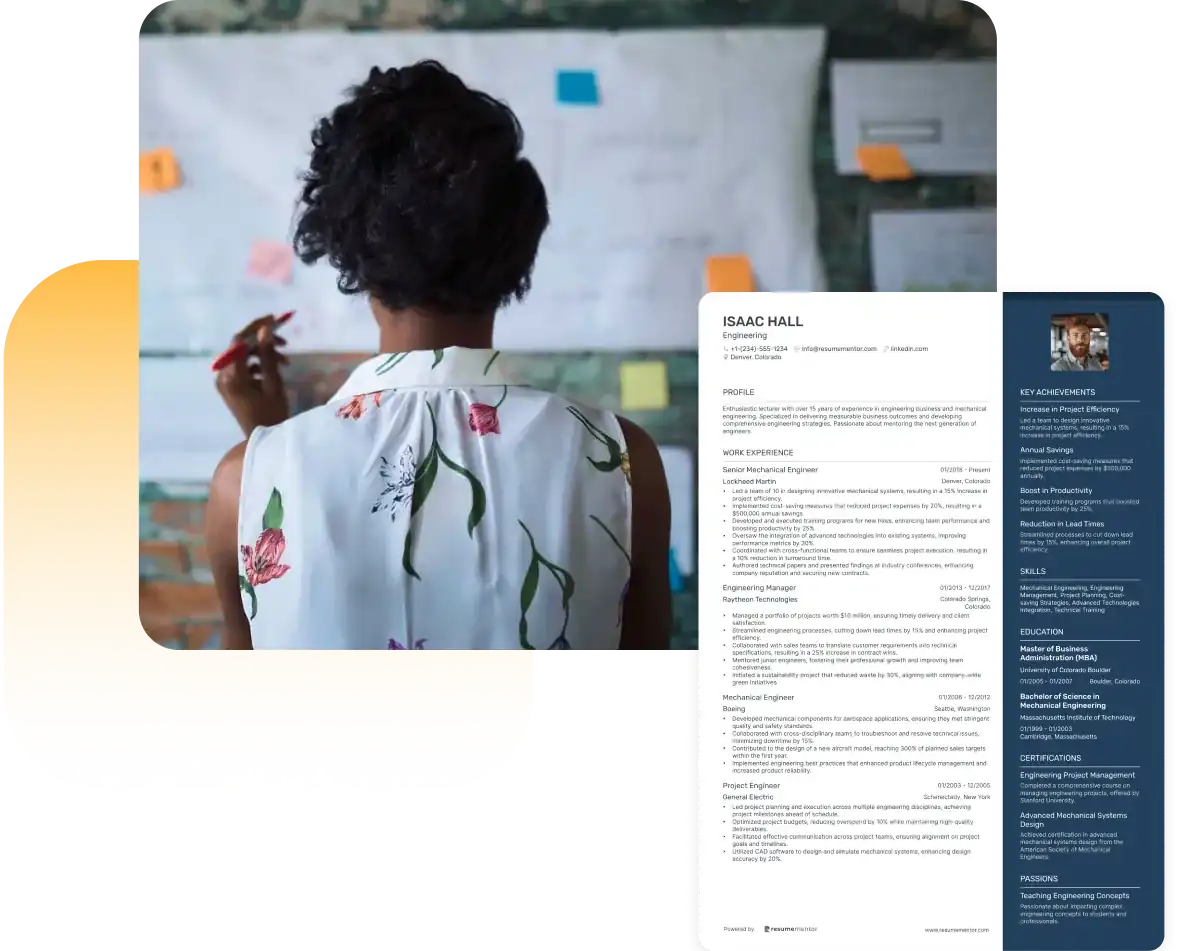
Continue Reading
Check more recommended readings to get the job of your dreams.
Resume
Resources
Tools
© 2025. All rights reserved.
Made with love by people who care.

